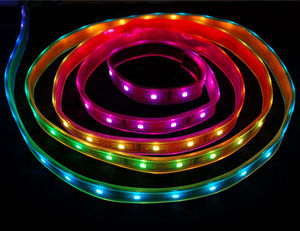We've launched our new site at www.openlighting.org. This wiki will remain and be updated with more technical information.
Difference between revisions of "OLA LED Pixels"
From wiki.openlighting.org
m |
|||
| Line 14: | Line 14: | ||
Only the WS2801 is supported in the 0.8.27 release. Code to support LPD8806 is in the git repo and will be in 0.7.28. | Only the WS2801 is supported in the 0.8.27 release. Code to support LPD8806 is in the git repo and will be in 0.7.28. | ||
| − | |||
== Hardware Setup == | == Hardware Setup == | ||
Revision as of 20:07, 7 March 2013
Since March 2013, OLA contains an SPI plugin, which allows you to drive strings of LEDs pixels provided your hardware has an SPI device. Using embedded Linux platforms like the Raspberry Pi, this allows one to build Pixel strings controlable via any of the supported protocols (ArtNet, E1.31, OSC & more) for < $100.
Alternatively if you don't want network control, you can send DMX512 to the LEDs using the Python, C++ or Java client library.
Supported Hardware
On the host side, any SPI hardware supported by the kernel should work correctly. By default OLA looks for devices in the form /dev/spi* .
On the LED pixel side the following is supported:
- LPD8806, e.g. https://www.adafruit.com/products/306
- WS2801, e.g. https://www.adafruit.com/products/738
Only the WS2801 is supported in the 0.8.27 release. Code to support LPD8806 is in the git repo and will be in 0.7.28.
Hardware Setup
TODO(someone): document this.
Software Setup
Once you have OLA running it's a matter of patching an SPI Output port to a universe and then patching the desired input port.
Configuration
The type of LED drivers, operating mode and DMX Start Address are configurable via RDM. Click on the RDM tab and you'll see the options.
The number of LEDs and SPI speed is set using the ola-spi.conf file.
